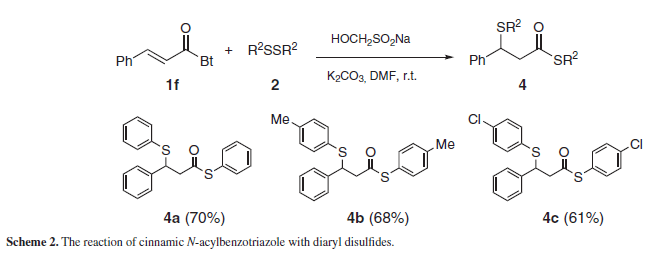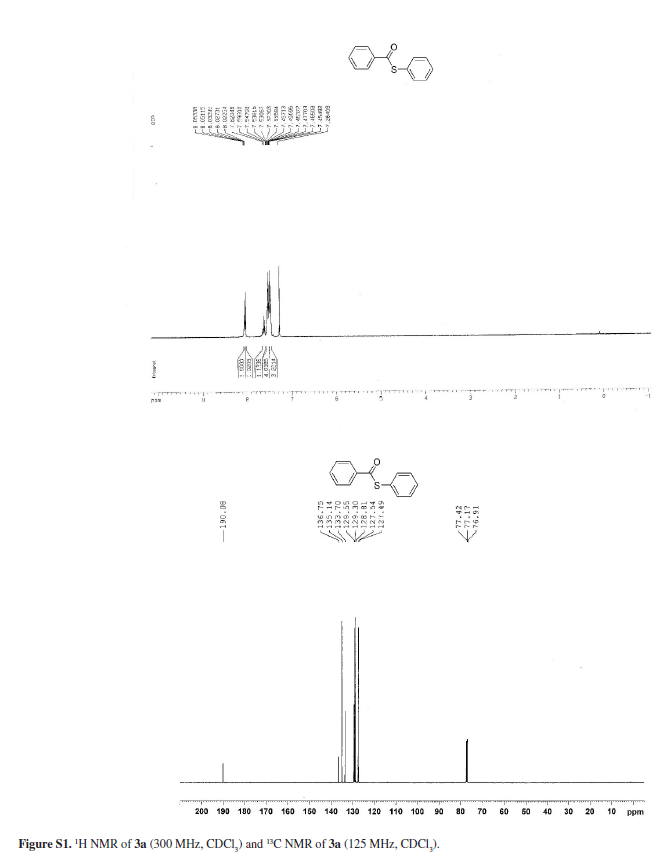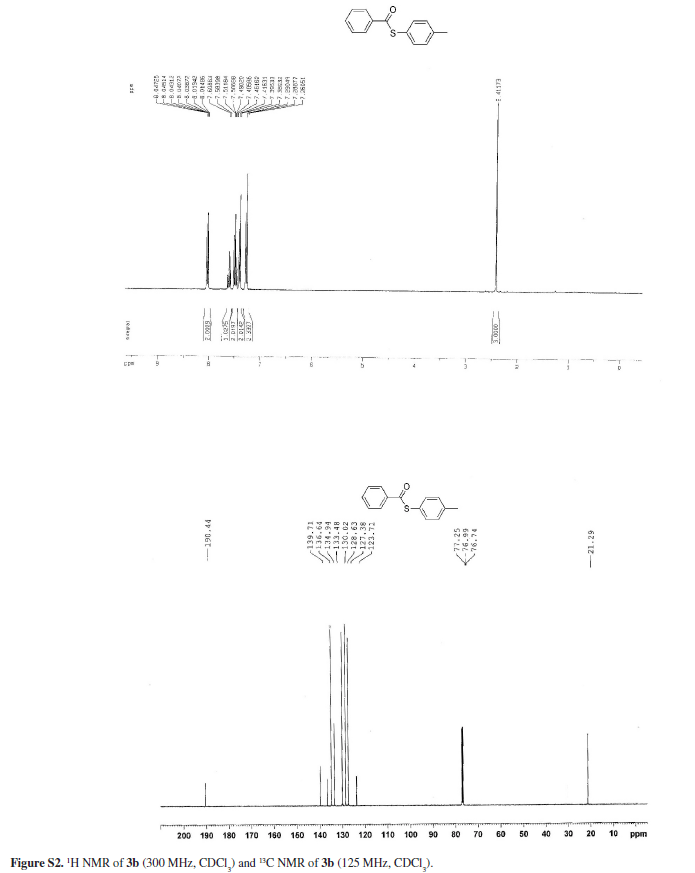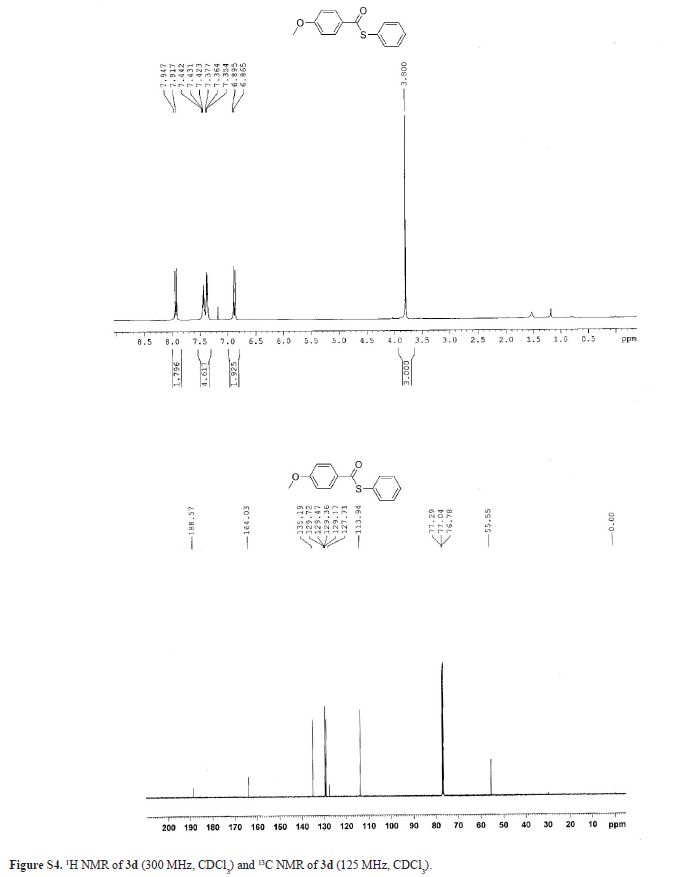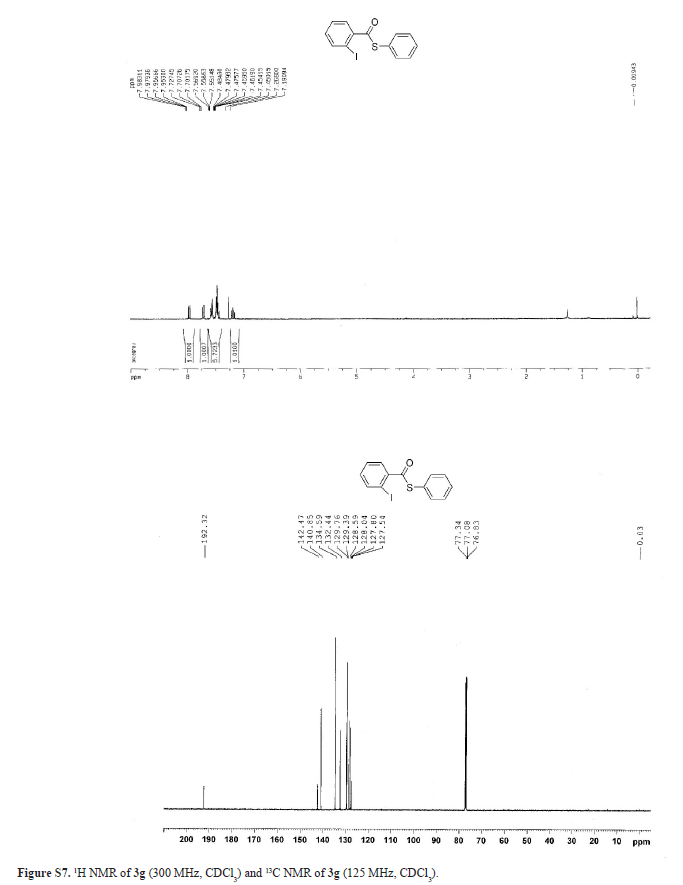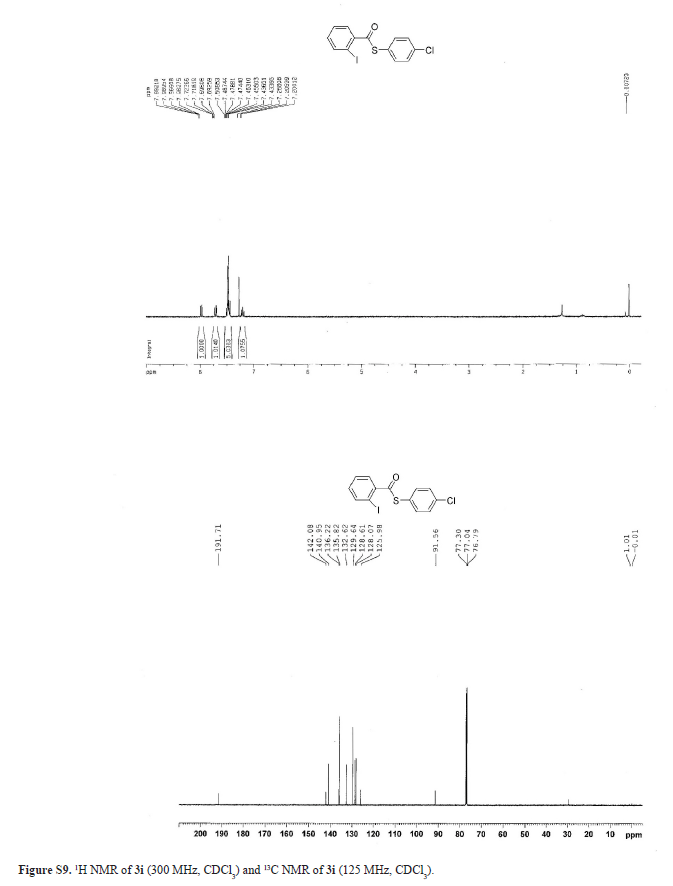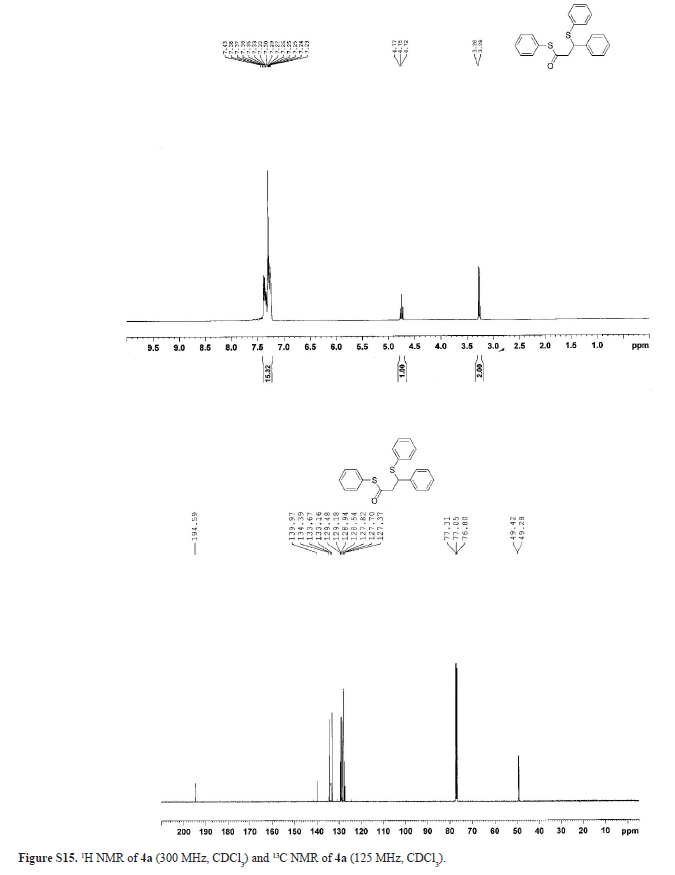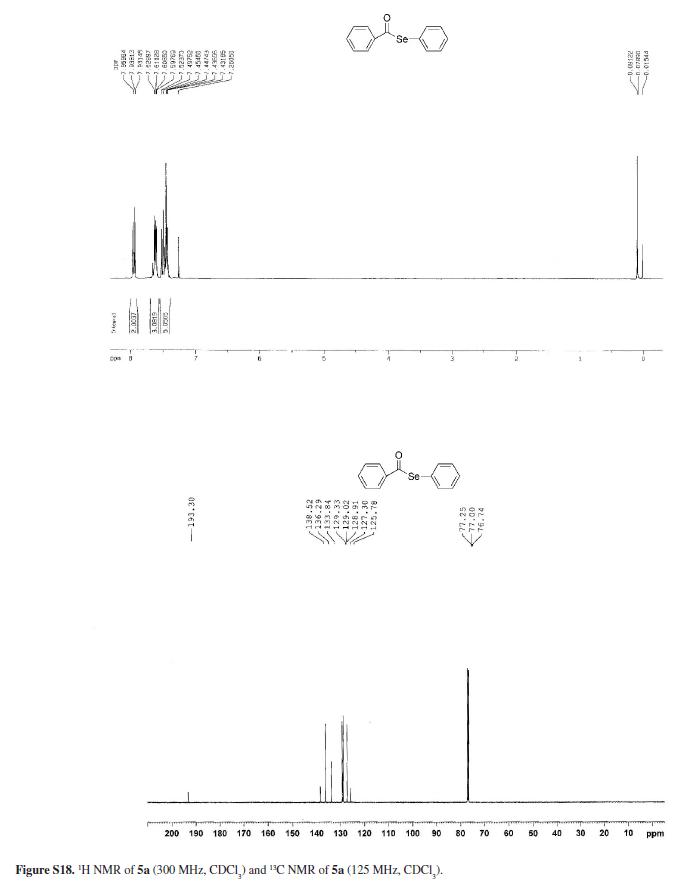Abstracts
Rongalite® promotes cleavage of diaryldisulfides generating the corresponding chalcogenolate anions that then undergo facile reaction with N-acylbenzotriazoles in the presence of K2CO3 to afford thioesters in good to excellent yields. The important features of this methodology are no requirement of metal catalysts, without any expensive reagent and high yields. It is noteworthy that the reactions of diphenyl diselenide with N-acylbenzotriazoles are also conducted to afford selenoesters in good yields under the standard conditions.
Rongalite; thioesters; selenoesters; N-acylbenzotriazoles; diaryl disulfide; diphenyldiselenide
Rongalite® promove a clivagem de diarildissulfetos gerando os calcogenolatos correspondentes, que reagem facilmente com N-acilbenzotriazóis na presença de K2CO3, produzindo tioésteres em bons a excelentes rendimentos. As principais características desta metodologia são a não necessidade de catalisdores metálicos ou de reagentes caros e o alto rendimento. É digno de nota que as reações de disseleneto de difenila com N-acilbenzotriazóis são também conduzidas para produzir selenoésteres em bons rendimentos sob condições normais.
ARTICLE
An approach to the synthesis of thioesters and selenoesters promoted by Rongalite®
Shao-Miao LinI; Ji-Lei ZhangI; Jiu-Xi ChenI,* * e-mail: jiuxichen@wzu.edu.cn, huayuewu@wzu.edu.cn ; Wen-Xia GaoI; Jin-Chang DingI,II; Wei-Ke SuI,III; Hua-Yue WuI,* * e-mail: jiuxichen@wzu.edu.cn, huayuewu@wzu.edu.cn
ICollege of Chemistry and Materials Engineering, Wenzhou University, 325035 Wenzhou, P. R. China
IIWenzhou Vocational and Technical College, 325035 Wenzhou, P. R. China
IIIZhejiang Key Laboratory of Pharmaceutical Engineering, College of Pharmaceutical Sciences, Zhejiang University of Technology, 310014 Hangzhou, P. R. China
ABSTRACT
Rongalite® promotes cleavage of diaryldisulfides generating the corresponding chalcogenolate anions that then undergo facile reaction with N-acylbenzotriazoles in the presence of K2CO3 to afford thioesters in good to excellent yields. The important features of this methodology are no requirement of metal catalysts, without any expensive reagent and high yields. It is noteworthy that the reactions of diphenyl diselenide with N-acylbenzotriazoles are also conducted to afford selenoesters in good yields under the standard conditions.
Keywords: Rongalite®, thioesters, selenoesters, N-acylbenzotriazoles, diaryl disulfide, diphenyldiselenide
RESUMO
Rongalite® promove a clivagem de diarildissulfetos gerando os calcogenolatos correspondentes, que reagem facilmente com N-acilbenzotriazóis na presença de K2CO3, produzindo tioésteres em bons a excelentes rendimentos. As principais características desta metodologia são a não necessidade de catalisdores metálicos ou de reagentes caros e o alto rendimento. É digno de nota que as reações de disseleneto de difenila com N-acilbenzotriazóis são também conduzidas para produzir selenoésteres em bons rendimentos sob condições normais.
Introduction
Thioesters have become increasingly important in the past few years because they have proven to be extremely useful intermediates for the preparation of heterocycles1 and diverse ketones,2 acyl radicals,3 and biologically active compounds.4 The typical procedure for the synthesis of thioesters involves the reaction of acylhalides with thiols,5 thiol sodium salts6 or disulfides.7 In addition, carboxylic acids are also transformed into thioesters by treatment with arylthiocyanates and tributyl phosphine in dichloromethane8 or with thiols by activated using tetramethyl fluoroformamidinium hexafluorophosphate,9 diphosgene10 and polyphosphate ester.11 Recently, Katritzky and co-workers12 introduced a new procedure for preparation of thioesters utilizing N-acylbenzotriazoles. Some other methods include palladium-catalyzed thiocarbonylation of iodoarenes with thiols in ionic liquid,13 rhodium-catalyzed alkylthio exchange reaction of thioester and disulfide,14 KF/Al2O3-catalyzed reaction of N-acylphthalimides with thiols15 and copper-catalyzed coupling of aryl iodides and thiobenzoic acid.16 However, these methods usually suffer from one or more limitations such as the use of unpleasant odor substrates thiols and expensive, toxic or metallic catalysts, long reaction times, unsatisfactory yields, as well as elevated temperature. Therefore, developing versatile approaches to synthesize thioesters still remains a highly desired goal in organic synthesis.
In continuation of our researches in developing novel synthetic routes for the formations of carbon-sulfur bonds17 and Rongalite®-promoted organic reactions,18 we here demonstrate further extension of this work together with application of Rongalite® (sodium formaldehyde sulfoxylate, HOCH2SO2Na) as an inexpensive reagent for the cleavage of diaryl disulfides or diphenyldiselenide and subsequent reaction with N-acylbenzotriazoles (Bt=1H-benzo[d][1,2,3]triazol-1-yl) to provide thioesters and selenoesters (Scheme 1).
Results and Discussion
At the onset of this work, we have investigated a variety of conditions with the model reaction of (1H-benzo[d][1,2,3]triazol-1-yl)(phenyl)methanone (1a) and diphenyl disulfide (2a) using Rongalite® as promoter (Table 1). First, we examined different solvents such as toluene, CH2Cl2, CH3CN, H2O, CH3CH2OH and DMF. Among the solvents screened, it was found that DMF is a much better solvent than all others tested (Table 1, entries 1-6). Next, we evaluated the loading amount of Rongalite®. No reaction was observed in the absence of Rongalite® and both starting materials were recovered in quantitative yields (Table 1, entry 7). In order to confirm, the amount of Rongalite® required for the above transformation, different experiments were carried out by varying the amount of Rongalite® (Table 1, entries 8-12). These results clearly indicate that, the use of 3 equiv. of Rongalite® is sufficient to promote the reaction in excellent yield. On the other hand, among the bases such as KF, Et3N, K3PO4, K2CO3 and Cs2CO3 tested, K2CO3 was found to be the best (Table 1, entries 6 and 13-16). We also checked the effect of the amount of K2CO3, the desired product 3a was afforded in 49% without K2CO3, increasing the amount of K2CO3 to 2 equiv., it was found that 1.5 equiv. resulted in excellent yield (Table 1, entries 17-20).
With the optimal conditions in hand, the scope of both disulfides and N-acylbenzotriazoles were explored and the results are summarized in (Table 2). As expected, this reaction proceeded smoothly and the desired products were afforded in good to excellent yields. A series of N-acylbenzotriazoles with either electron-donating or electron-withdrawing groups attached to aromatic ring were investigated. The substitution groups on the aromatic ring had no obvious effect on the yield. We also examined reaction of aliphatic N-acylbenzotriazole such as 1-(1H-benzo[d][1,2,3]triazol-1-yl)propan-1-one (1d), the desired products of 3j-3l were afforded in good yields (Table 2, entries 10-12). Similarly, 3m and 3n were afforded from heterocyclic N-acylbenzotriazole such as (1H-benzo[d][1,2,3]triazol-1-yl) (furan-2-yl)methanone (1e) in moderate yields (Table 2, entries 13-14). Unfortunately, attempt to acylation of dibenzyl disulfide, an aliphatic disulfide, with (1H-benzo[d][1,2,3]triazol-1-yl)(phenyl)methanone (1a) failed to give the expected thioesters.
Interestingly, when cinnamic N-acylbenzotriazole (1f) was used, the corresponding multi-sulfur substitution compounds of 4a-4c were afforded in moderate yields (Scheme 2).
On the other hand, we extended this method to prepare selenoesters starting from N-acylbenzotriazoles. Selenoesters are important intermediates in several organic transformations. Selenoesters have been used as precursors of acyl radicals19 and anions,20 mild acyl transfer reagents,21 intermediates in the synthesis of ketones,22 and for asymmetric aldol reactions.23 Under the same conditions, we used diphenyldiselenide as source of selenolate anion, the reaction with N-acylbenzotriazoles afforded the corresponding selenoesters 5a-5d in the presence of Rongalite® and K2CO3 (Scheme 3). However, acylation of aliphatic diselenide, such as dibenzyl diselenide and dimethyl diselenide, was still unsuccessful under the standard conditions.
In summary, N-acylbenzotriazoles have been introduced as new efficient S-acylating reagents. The reactions have been demonstrated under mild conditions to give diverse thioesters and selenoesters with moderate to good yield. Rongalite® as an inexpensive promoting reagent for these transformations can be substantiated by short reaction times, which is an additional advantage of this protocol. Efforts to explore the detailed mechanism and further applications of the present system in other transformations using disulfide and diselenide as a reaction partner are ongoing in our group.
Experimental
Chemicals and solvents were either purchased or synthesized by standard techniques. The reagents of N-acylbenzotriazoles were synthesized by reaction of the corresponding carboxylic acids with BtH and SOCl2 following the reported one-step general procedure.24 Melting points were recorded on Digital Melting Point Apparatus WRS-1B and are uncorrected. 1H NMR and 13C NMR spectra were taken on a Bruker DPX300 spectrometer using CDCl3 or DMSO-d6 as the solvent with tetramethylsilane (TMS) as an internal standard at room temperature. Chemical shifts were given in d relative to TMS, the coupling constants J are given in Hz. Mass spectrometric analysis was performed on GC-MS analysis (SHIMADZU GCMS-QP2010). Elemental analysis was determined on a Carlo-Erba 1108 instrument.
General procedure for the preparation of thioesters 3, 4 and selenoesters 5
A mixture of N-acylbenzotriazoles 1 (0.4 mmol), diaryl disulfides 2 or diphenyldiselenide (0.2 mmol), Rongalite® (3 equiv.), and K2CO3 (1.5 equiv.) in DMF (3 mL) was stirred for the corresponding time at room temperature under air. After the reaction was finished, the reaction mixture was washed with water, extracted with ethyl acetate (3 × 10 mL), the organic phase was separated and dried over anhydrous sodium sulfate, filtered and the solvent was evaporated under vacuum. The residue was purified by flash column chromatography (ethyl acetate or hexane/ethyl acetate) to afford the desired product thioesters 3 or selenoesters 5. If cinnamic N-acylbenzotriazole 1f was used the reaction substrate, the amount of diaryl disulfides 2 is 0.4 mmol.
Supplementary Information
Supplementary data are available free of charge at http://jbcs.sbq.org.br, as PDF file.
Acknowledgments
We are grateful to the National Key Technology R&D Program (No. 2007BAI34B00) and the Natural Science Foundation of Zhejiang Province (No. Y4080107) for financial support.
References
1. Chen, J.; Forsyth, C. J.; Org. Lett. 2003, 5, 1281; Brule, C.; Bouillon, J. P.; Nicolaï, E.; Portella, C.; Synthesis 2003, 436.
2. McGarvey, G. J.; Williams, M.; Hiner, R. N.; Matsubara, Y.; Oh, T.; J. Am. Chem. Soc. 1986, 108, 4943; Conrow, R.; Portoghese, P. S.; J. Org. Chem. 1986, 51, 938; Shimizu, T.; Seki, M.; Tetrahedron Lett. 2002, 43, 1039; Dieter, R. K.; Tetrahedron 1999, 55, 4177; Ikeda, Z.; Hirayama, T.; Matsubara, S.; Angew. Chem., Int. Ed. 2006, 45, 8200; Villalobos, J. M.; Srogl, J.; Liebeskind, L. S.; J. Am. Chem. Soc. 2007, 129, 15734.
3. Ozaki, S.; Adachi, M.; Sekiya, S.; Kamikawa, R.; J. Org. Chem. 2003, 68, 4586.
4. Turpin, J. M.; Song, Y.; Inman, J. K.; Huang, M.; Wallqvist, A.; Maynard, A.; Covell, D. G.; Rice, W. G.; Appella, E.; J. Med. Chem. 1999, 42, 67.
5. Detty, M. R.; Wood, G. P.; J. Org. Chem. 1980, 45, 80; Harpp, D. N.; Aida, T.; Chan, T. H.; Tetrahedron Lett. 1979, 31, 2853; Meshram, H. M.; Reddy, G. S.; Bindu, K. H.; Yadav, J. S.; Synthesis 1998, 877; Shah, S. T. A.; Khan, K. M.; Hussain, H.; Hayat, S.; Voelter, W.; Monatsh. Chem. 2005, 136, 1583; Chen, R. E.; Zhang Y. M.; Synth. Commun. 1999, 29, 3699; Polshettiwar, V.; Kaushik, M. P.; Catal. Commun. 2005, 6, 191.
6. Tajima, Y.; Yoshida, A.; Takeda, N.; Oida, S.; Tetrahedron Lett. 1985, 26, 673; Haynes, R. K.; Vonwiller, S. C.; Stokes, J. P.; Merlino, L. M.; Aust. J. Chem. 1988, 41, 881; Choi, J.; Imai, E.; Mihara, M.; Oderaotoshi, Y.; Minakata, S.; Komatsu, M.; J. Org. Chem. 2003, 68, 6164.
7. Brindaban, C. R.; Tanmay, M.; J. Org. Chem. 2004, 69, 5793; Lakouraj, M. M.; Movassagh, B.; Fadaei, Z.; Monatsh. Chem. 2002, 133, 1085.
8. Grieco, P. A.; Yokoyama, Y.; Williams, E.; J. Org. Chem. 1978, 43, 1283.
9. Pittelkow, M.; Kamounah, F. S.; Boas, U.; Pedersen, B.; Christensen, J. B.; Synthesis 2004, 2485.
10. Ravi, D.; Rama Rao, N.; Reddy, G. S. R.; Sucheta, K.; Jayathirtha Rao, V.; Synlett 1994, 856.
11. Imamoto, T.; Kodera, M.; Yokoyama, M.; Synthesis 1982, 134.
12. Katritzky, A. R.; Shestopalov , A. A.; Suzuki, K.; Synthesis 2004, 1806.
13. Cao, H.; McNamee, L.; Alper, H.; J. Org. Chem. 2008, 73, 3530.
14. Arisawa, M.; Kubota, T.; Yamaguchi, M.; Tetrahedron Lett. 2008, 49, 1975.
15. Movassagha, B.; Zakinezhad, Y.; J. Chem. Res. (S) 2006, 369.
16. Sawada, N.; Itoh, T.; Yasuda, N.; Tetrahedron Lett. 2006, 47, 6595.
17. Yang, X. L.; Xu, C. M.; Lin, S. M.; Chen, J. X.; Ding, J. C.; Wu, H. Y.; Su, W. K.; J. Braz. Chem. Soc. 2010, 21, 37; Xiao, H. L.; Chen, J. X.; Liu, M. C.; Zhu, D. J.; Ding, J. C.; Wu, H. Y.; Chem. Lett. 2009, 38, 170; Yang, X. L.; Xu, Y. L.; Chen, J. X.; Ding, J. C.; Wu, H. Y.; Su, W. K.; J. Chem. Res. 2009, 682; Zhu, D. J.; Chen, J. X.; Xiao, H. L.; Liu, M. C.; Ding, J. C.; Wu, H. Y.; Synth. Commun. 2009, 39, 2895; Chen, J. X.; Wu, H. Y.; Jin, C.; Zhang, X. X.; Xie, Y. Y.; Su, W. K.; Green Chem. 2006, 8, 330; Chen, J. X.; Su, W. K.; Wu, H. Y.; Liu, M. C.; Jin, C.; Green Chem. 2007, 9, 972; Su, W. K.; Chen, J. X.; Wu, H. Y.; Jin, C.; J. Org. Chem. 2007, 72, 4524.
18. Guo, W. X.; Chen, J. X.; Wu, D. Z.; Ding, J. C.; Chen, F.; Wu, H. Y.; Tetrahedron 2009, 65, 5240.
19. Keck, G.; Grier, M. C.; Synlett 1999, 1657; Boger, D. L.; Mathvink, R. J.; J. Org. Chem. 1992, 57, 1429; Chen, C.; Crich, D.; Papadatos, A.; J. Am. Chem. Soc. 1992, 114, 8313.
20. Hiiro, T.; Morita, Y.; Inoue, T.; Kambe, N.; Ogawa, A.; Ryu, I.; Sonoda, N.; J. Am. Chem. Soc. 1990, 112, 455.
21. Mukaiyama, T.; Araki, M.; Takei, H.; J. Am. Chem. Soc. 1973, 95, 4763; Anderson, R. J.; Henrick, C. A.; Rosenblum, L. D.; J. Am. Chem. Soc. 1974, 96, 3654; Sviridov, A. F.; Ermolenko, M. S.; Yashunsky, D. V.; Kochetkov, N. K.; Tetrahedron Lett. 1983, 24, 4355.
22. Back, T. G.; Kerr, R. G.; Tetrahedron 1982, 38, 3241; Back, T. G.; Kerr, R. G.; Tetrahedron 1985, 41, 4759.
23. Mukaiyama, T.; Uchiro, H.; Shiina, I.; Kobayashi, S.; Chem. Lett. 1990, 1019; Kobayashi, S.; Uchiro, H.; Fujishita, Y.; Shiina, I.; Mukaiyama, T.; J. Am. Chem. Soc. 1991, 113, 4247; Suh, K. H.; Choo, D. J.; Tetrahedron Lett. 1995, 36, 6109.
24. Katritzky, A. R.; Zhang, Y.; Singh, S. K.; Synthesis 2003, 2795.
Submitted: January 12, 2010
Published online: May 7, 2010
Supplementary Information
Description of the Products
Compounds 3a-3h, 3j-3m, 3o-3p, 4a-4d are known, compounds 3i, 3n and 3q are new and described below.
S-Phenyl thiobenzoate (3a)
White solid; mp 51-52 ºC (Lit.1 mp 54-58 ºC); 1H NMR (300 MHz, CDCl3): δ 7.45-7.62 (m, 8H), 8.02-8.05 (m, 2H); 13C NMR (125 MHz, CDCl3): δ 127.49, 127.54, 128.81, 129.30, 129.55, 133.70, 135.14, 136.75, 190.08.
S-4-Tolyl thiobenzoate (3b)
White solid; mp 70-71 ºC (Lit.2 mp 65-66 ºC); 1H NMR (300 MHz, CDCl3): δ 2.41 (s, 3H),7.29-7.61 (m, 7H), 8.01-8.05 (m, 2H); 13C NMR (125 MHz, CDCl3): δ 21.29, 123.71, 127.38, 128.63, 130.02, 133.48, 134.94, 136.64, 139.71, 190.44.
S-4-Chlorophenyl thiobenzoate (3c)
White solid; mp 71-72 ºC (Lit.3 mp 73-74ºC); 1H NMR (300 MHz, CDCl3): δ 7.44-7.63 (m, 7H), 8.00-8.03 (m, 2H); 13C NMR (125 MHz, CDCl3): δ 125.81, 127.47, 128.78, 129.46, 133.82, 135.94, 136.27, 136.32, 189.55.
S-Phenyl, 4-methoxythiobenzoate (3d)
White solid; mp 93-95 ºC (Lit.4 mp 98-99 ºC); 1H NMR (300 MHz, CDCl3): δ 3.80 (s, 3H), 6.88 (d, J 9 Hz, 2H), 7.35-7.44 (m, 5H), 7.93 (d, J 9Hz, 2H); 13C NMR (125 MHz, CDCl3): δ 55.55, 113.94, 127.71, 129.17, 129.36, 129.47, 129.72, 135.19, 164.03, 188.57.
S-4-Tolyl 4-methoxythiobenzoate (3e)5
White solid; mp 59-62 ºC; 1H NMR (300 MHz, CDCl3): δ 2.41 (s, 3H), 3.89 (s, 3H), 6.96 (d, J 9 Hz, 2H), 7.25-7.28 (m, 2H), 7.40 (d, J 8Hz, 2H), 8.01 (d, J 9Hz, 2H); 13C NMR (125 MHz, CDCl3): δ 20.31, 54.50, 112.87, 123.10, 128.52, 128.65, 128.99, 134.08, 138.57, 162.93, 187.94.
S-4-Chlorophenyl 4-methoxythiobenzoate (3f)
White solid; mp 93-94 ºC (Lit.6 mp 98-101 ºC); 1H NMR (300 MHz, CDCl3): δ 3.81 (s, 3H), 6.88-6.91 (m, 2H), 7.35 (m, 4H), 7.92 (d, J 6.9 Hz, 2H); 13C NMR (125 MHz, CDCl3): δ 55.57, 114.01, 126.22, 129.16, 129.41, 129.77, 135.81, 136.39, 164.18, 188.00.
S-Phenyl 2-iodothiobenzoate (3g)7
White solid; mp 54-56 ºC; 1H NMR (300 MHz, CDCl3): δ 7.19 (t, 1H), 7.45-7.60 (m, 6H), 7.70-7.73 (m, 1H), 7.95-7.98 (m, 1H); 13C NMR (125 MHz, CDCl3): δ 127.54, 127.80, 128.04, 128.59, 129.39, 129.76, 132.44, 134.59, 140.85, 142.47, 192.32.
S-4-Tolyl 2-iodothiobenzoate (3h)8
White solid; mp 60-63 ºC; 1H NMR (300 MHz, CDCl3): δ 2.41 (s, 3H), 7.18 (t, 1H), 7.27-7.47 (m, 5H), 7.71 (d, J 8 Hz, 1H), 7.96 (d, J 8 Hz, 1H); 13C NMR (125 MHz, CDCl3): δ 21.54, 123.99, 128.00, 128.57, 129.98, 130.23, 132.36, 134.55, 140.08, 140.82, 142.58, 192.80.
S-4-Chlorophenyl 2-iodothiobenzoate (3i)
White solid; mp 82-85 ºC; 1H NMR (300 MHz, CDCl3): δ 7.20-7.21 (m, 1H), 7.43 -7.51 (m, 5H), 7.69-7.72 (m, 1H), 7.96-7.99 (m, 1H); 13C NMR (125 MHz, CDCl3): δ 91.56, 125.98, 128.07, 128.61, 129.64, 132.62, 135.82, 136.22, 140.95, 142.08, 191.71. ESI-MS: m/z (%): 376 ([M+2]+, 32), 374 (M+, 100). Anal. calc. for C13H8ClIOS: C, 41.68; H, 2.15; Found: C, 41.72; H, 2.21.
S-Phenyl thiopropionate (3j)9
Oil; 1H NMR (300 MHz, CDCl3): δ 1.24 (t, J 7.50 Hz, 3H), 2.70 (q, J 7.49 Hz, 2H), 7.42-7.43 (m, 5H); 13C NMR (125 MHz, CDCl3): δ 8.75, 36.09, 126.91, 128.12, 128.26, 133.50, 197.13.
S-4-Tolyl thiopropionate (3k)3
Oil; 1H NMR (300 MHz, CDCl3): δ 1.21 (t, J 7.47 Hz, 3H), 2.36 (s, 3H), 2.67 (q, J 7.50 Hz, 2H), 7.19 -7.30 (m, 4H); 13C NMR (125 MHz, CDCl3): δ 9.53, 21.20, 36.90, 124.30, 129.89, 134.39, 139.43, 198.57.
S-4-Chlorophenyl thiopropionate (3l)3
Oil; 1H NMR (300 MHz, CDCl3): δ 1.23 (t, J 7.48 Hz, 3H), 2.69 (q, J 7.48 Hz, 2H), 7.32 -7.41 (m, 4H); 13C NMR (125 MHz, CDCl3): δ 8.43, 36.09, 126.87, 128.12, 128.26, 133.50, 197.16.
S-Phenyl 2-Furancarbothioate (3m)
White solid; mp 51-52 ºC (Lit.10 mp 51-52 ºC); 1H NMR (300 MHz, CDCl3): δ 6.58-6.60 (m, 1H), 7.27 (d, J 3.6 Hz, 1H), 7.46-7.63 (m, 5H), 7.64 (s, 1H); 13C NMR (125 MHz, CDCl3): δ 111.39, 115.21, 125.23, 128.23, 128.55, 134.12, 145.45, 149.39, 177.59.
S-4-Tolyl 2-Furancarbothioate (3n)
White solid; mp 63-65ºC; 1H NMR (300 MHz, CDCl3): δ 2.41 (s, 3H), 6.57-6.59 (m, 1H), 7.25-7.41 (m, 5H), 7.63 (m, 1H); 13C NMR (125 MHz, CDCl3): δ 21.34, 112.35, 116.09, 122.64, 130.10, 135.06, 139.95, 146.37, 150.49, 179.06. ESI-MS: m/z (%): 218 (M+, 100). Anal. calc. for C12H10O2S: C, 66.03; H, 4.62; Found: C, 60.10; H, 4.59.
S-Phenyl 3-phenyl-3-(phenylthio)propanethioate (4a)11
White solid; mp 74-76ºC; 1H NMR (300 MHz, CDCl3): δ 3.27 (d, J 6 Hz, 2H), 4.75 (t, J 6 Hz, 1H), 7.23-7.43 (m, 15H); 13C NMR (125 MHz, CDCl3): δ 49.28, 49.42, 127.37, 127.70, 127.82, 128.54, 128.94, 129.18, 129.48, 133.67, 134.39, 139.97, 194.59.
S-4-Tolyl 3-phenyl-3-(phenylthio)propanethioate (4b)12
White solid; mp 82-83 ºC; 1H NMR (300 MHz, CDCl3): δ 2.34 (s, 3H), 2.38 (s, 3H), 3.26 (d, J 7.6 Hz, 2H), 4.70 (t, J 7.6 Hz, 1H), 7.07-7.32 (m, 13H); 13C NMR (125 MHz, CDCl3): δ 21.10, 21.26, 49.08, 49.44, 127.50, 127.74, 128.38, 128.91, 129.63, 129.68, 129.99, 133.70, 134.26, 138.23, 139.66, 139.96, 194.59.
S-4-Chlorophenyl 3-(4-chlorophenylthio)-3-phenylpropanethioate (4c)
White solid; mp 63-65 ºC; 1H NMR (300 MHz, CDCl3): δ 3.24 (d, J 7.5 Hz, 2H) , 4.69 (t, J 7.6 Hz, 1H), 7.19-7.43 (m, 13H); 13C NMR (125 MHz, CDCl3): δ 49.22, 49.43, 123.9, 125.6, 1207.7, 128.6, 129.4, 130.9, 131.8, 134.2, 135.5, 135.8, 139.5, 141.9, 193.9. ESI-MS: m/z (%): 422 ([M+4]+, 10), 420 ([M+2]+, 36), 418 (M+, 100). Anal. calc. for C21H16Cl2OS2: C, 60.14; H, 3.85; Found: C, 60.08; H, 3.94.
Se-Phenyl selenobenzoate (5a)
Yellow solid; mp 40-41 ºC (Lit .12 mp 37-38 ºC); 1H NMR (300 MHz, CDCl3): δ 7.43-7.52 (m, 5H), 7.60-7.63 (m, 3H), 7.93-7.96 (m, 2H); 13C NMR (125 MHz, CDCl3): δ 125.78, 127.30, 128.91, 129.02, 129.33, 133.84, 136.29, 138.52, 192.30.
Se-phenyl 4-methoxyselenobenzoate (5b)
White solid; mp 56-58 ºC (Lit.13 mp 61-62 ºC); 1H NMR (300 MHz, CDCl3): δ 6.96 (d, J 6.9Hz, 2H), 7.42-7.44 (m, 3H), 7.59-7.63 (m, 2H), 7.92 (d, J 6.9Hz, 2H); 13C NMR (125 MHz, CDCl3): δ 55.52, 114.05, 125.97, 128.84, 129.22, 129.61, 131.25, 136.35, 164.14, 191.20..
Se-Phenyl 2-iodoselenobenzoate (5c)
Yellow solid; mp 59-60 ºC (Lit.14 mp 76 ºC); 1H NMR (300 MHz, CDCl3): δ 7.18-7.18 (m, 1H), 7.43-7.7.45 (m, 4H), 7.63-7.69 (m, 3H), 7.96 (d, J 7.9Hz, 1H); 13C NMR (125 MHz, CDCl3): δ 90.20, 126.65, 128.01, 128.39, 129.17, 129.45, 132.53, 135.75, 140.97, 143.76, 195.61..
Se-Phenyl 2-Furancarboseleno (5d)15
Oil; 1H NMR (300 MHz, CDCl3): δ 6.59-6.60 (m, 1H), 7.21-7.23 (m, 1H), 7.41-7.44 (m, 3H), 7.58-7.63 (m, 3H); 13C NMR (125 MHz, CDCl3): δ 112.77, 115.18, 124.74, 129.10, 129.32, 136.30, 146.57, 151.74, 180.72.
References
1. Katritzky, A. R.; Shestopalov, A. A.; Suzuki, K.; Synthesis 2004, 1806.
2. Movassagh, B.; Zakinezhad, Y.; J. Chem. Res. 2006, 369.
3. Barbero, M.; Degani, I.; Dughera, S.; Fochi, R.; Synthesis 2003, 1225.
4. Os'kina, I. A.; Vlasov, V. M.; Russian J. Org. Chem. 2008, 44, 561.
5. Kingsbury, C. A.; Phosphorus, Sulfur Silicon Relat. Elem.1981, 9, 315.
6. Brindaban, C. R.; Tanmay, M.; J. Org. Chem. 2004, 69, 5793.
7. Nyquist, R. A.; Potts, W. J.; Spectrochim. Acta 1959, 514.
8. Buchholz, G.; Martens, J.; Praefcke, K.; Synthesis 1974, 9, 666.
9. Danheiser, R. L.; Nowick, J. S.; J. Org. Chem. 1991, 56, 1176.
10. Katritzky, A. R.; Shestopalov , A. A.; Suzuki, K.; Synthesis 2004, 1806.
11. Marzorati, L.; Carlos de Mattos, M.; Wladislaw, B.; Di Vitta, C.; Synth. Commun. 2002, 32, 1427.
12. Marin, G.; Braga, A. L.; Rosa, A. S.; Tetrahedron 2009, 65, 4614.
13. Kato, S.; Kabuto, H.; Ishihara, H.; Murai, T.; Synthesis 1985, 520.
14. Renson, M.; Bulletin des Societes Chimiques Belges 1962, 71, 260.
15. Munbunjong, W.; Lee, E. H.; Ngernmaneerat, P.; Kim, S. J.; Singh, G.; Chavasiri, W.; Jang, D.O.; Tetrahedron 2009, 65, 2467.
Figure S1 - Click to enlarge
Figure S2 - Click to enlarge
Figure S3 - Click to enlarge
Figure S4 - Click to enlarge
Figure S5 - Click to enlarge
Figure S6 - Click to enlarge
Figure S7 - Click to enlarge
Figure S8 - Click to enlarge
Figure S9 - Click to enlarge
Figure S10 - Click to enlarge
Figure S11 - Click to enlarge
Figure S12 - Click to enlarge
Figure S13 - Click to enlarge
Figure S14 - Click to enlarge
Figure S15 - Click to enlarge
Figure S16 - Click to enlarge
Figure S17 - Click to enlarge
Figure S18 - Click to enlarge
Figure S19 - Click to enlarge
Figure S20 - Click to enlarge
Figure S21 - Click to enlarge
- 1. Chen, J.; Forsyth, C. J.; Org. Lett. 2003, 5, 1281;
- Brule, C.; Bouillon, J. P.; Nicolaï, E.; Portella, C.; Synthesis 2003, 436.
- 2. McGarvey, G. J.; Williams, M.; Hiner, R. N.; Matsubara, Y.; Oh, T.; J. Am. Chem. Soc. 1986, 108, 4943;
- Conrow, R.; Portoghese, P. S.; J. Org. Chem. 1986, 51, 938;
- Shimizu, T.; Seki, M.; Tetrahedron Lett. 2002, 43, 1039;
- Dieter, R. K.; Tetrahedron 1999, 55, 4177;
- Ikeda, Z.; Hirayama, T.; Matsubara, S.; Angew. Chem., Int. Ed. 2006, 45, 8200;
- Villalobos, J. M.; Srogl, J.; Liebeskind, L. S.; J. Am. Chem. Soc. 2007, 129, 15734.
- 3. Ozaki, S.; Adachi, M.; Sekiya, S.; Kamikawa, R.; J. Org. Chem. 2003, 68, 4586.
- 4. Turpin, J. M.; Song, Y.; Inman, J. K.; Huang, M.; Wallqvist, A.; Maynard, A.; Covell, D. G.; Rice, W. G.; Appella, E.; J. Med. Chem. 1999, 42, 67.
- 5. Detty, M. R.; Wood, G. P.; J. Org. Chem. 1980, 45, 80;
- Harpp, D. N.; Aida, T.; Chan, T. H.; Tetrahedron Lett. 1979, 31, 2853;
- Meshram, H. M.; Reddy, G. S.; Bindu, K. H.; Yadav, J. S.; Synthesis 1998, 877;
- Shah, S. T. A.; Khan, K. M.; Hussain, H.; Hayat, S.; Voelter, W.; Monatsh. Chem. 2005, 136, 1583;
- Chen, R. E.; Zhang Y. M.; Synth. Commun. 1999, 29, 3699;
- Polshettiwar, V.; Kaushik, M. P.; Catal. Commun. 2005, 6, 191.
- 6. Tajima, Y.; Yoshida, A.; Takeda, N.; Oida, S.; Tetrahedron Lett. 1985, 26, 673;
- Haynes, R. K.; Vonwiller, S. C.; Stokes, J. P.; Merlino, L. M.; Aust. J. Chem. 1988, 41, 881;
- Choi, J.; Imai, E.; Mihara, M.; Oderaotoshi, Y.; Minakata, S.; Komatsu, M.; J. Org. Chem. 2003, 68, 6164.
- 7. Brindaban, C. R.; Tanmay, M.; J. Org. Chem. 2004, 69, 5793;
- Lakouraj, M. M.; Movassagh, B.; Fadaei, Z.; Monatsh. Chem. 2002, 133, 1085.
- 8. Grieco, P. A.; Yokoyama, Y.; Williams, E.; J. Org. Chem. 1978, 43, 1283.
- 9. Pittelkow, M.; Kamounah, F. S.; Boas, U.; Pedersen, B.; Christensen, J. B.; Synthesis 2004, 2485.
- 10. Ravi, D.; Rama Rao, N.; Reddy, G. S. R.; Sucheta, K.; Jayathirtha Rao, V.; Synlett 1994, 856.
- 11. Imamoto, T.; Kodera, M.; Yokoyama, M.; Synthesis 1982, 134.
- 12. Katritzky, A. R.; Shestopalov , A. A.; Suzuki, K.; Synthesis 2004, 1806.
- 13. Cao, H.; McNamee, L.; Alper, H.; J. Org. Chem. 2008, 73, 3530.
- 14. Arisawa, M.; Kubota, T.; Yamaguchi, M.; Tetrahedron Lett. 2008, 49, 1975.
- 15. Movassagha, B.; Zakinezhad, Y.; J. Chem. Res. (S) 2006, 369.
- 16. Sawada, N.; Itoh, T.; Yasuda, N.; Tetrahedron Lett. 2006, 47, 6595.
- 17. Yang, X. L.; Xu, C. M.; Lin, S. M.; Chen, J. X.; Ding, J. C.; Wu, H. Y.; Su, W. K.; J. Braz. Chem. Soc. 2010, 21, 37;
- Xiao, H. L.; Chen, J. X.; Liu, M. C.; Zhu, D. J.; Ding, J. C.; Wu, H. Y.; Chem. Lett. 2009, 38, 170;
- Yang, X. L.; Xu, Y. L.; Chen, J. X.; Ding, J. C.; Wu, H. Y.; Su, W. K.; J. Chem. Res. 2009, 682;
- Zhu, D. J.; Chen, J. X.; Xiao, H. L.; Liu, M. C.; Ding, J. C.; Wu, H. Y.; Synth. Commun. 2009, 39, 2895;
- Chen, J. X.; Wu, H. Y.; Jin, C.; Zhang, X. X.; Xie, Y. Y.; Su, W. K.; Green Chem. 2006, 8, 330;
- Chen, J. X.; Su, W. K.; Wu, H. Y.; Liu, M. C.; Jin, C.; Green Chem. 2007, 9, 972;
- Su, W. K.; Chen, J. X.; Wu, H. Y.; Jin, C.; J. Org. Chem. 2007, 72, 4524.
- 18. Guo, W. X.; Chen, J. X.; Wu, D. Z.; Ding, J. C.; Chen, F.; Wu, H. Y.; Tetrahedron 2009, 65, 5240.
- 19. Keck, G.; Grier, M. C.; Synlett 1999, 1657;
- Boger, D. L.; Mathvink, R. J.; J. Org. Chem. 1992, 57, 1429;
- Chen, C.; Crich, D.; Papadatos, A.; J. Am. Chem. Soc. 1992, 114, 8313.
- 20. Hiiro, T.; Morita, Y.; Inoue, T.; Kambe, N.; Ogawa, A.; Ryu, I.; Sonoda, N.; J. Am. Chem. Soc. 1990, 112, 455.
- 21. Mukaiyama, T.; Araki, M.; Takei, H.; J. Am. Chem. Soc. 1973, 95, 4763;
- Anderson, R. J.; Henrick, C. A.; Rosenblum, L. D.; J. Am. Chem. Soc. 1974, 96, 3654;
- Sviridov, A. F.; Ermolenko, M. S.; Yashunsky, D. V.; Kochetkov, N. K.; Tetrahedron Lett 1983, 24, 4355.
- 22. Back, T. G.; Kerr, R. G.; Tetrahedron 1982, 38, 3241;
- Back, T. G.; Kerr, R. G.; Tetrahedron 1985, 41, 4759.
- 23. Mukaiyama, T.; Uchiro, H.; Shiina, I.; Kobayashi, S.; Chem. Lett. 1990, 1019;
- Kobayashi, S.; Uchiro, H.; Fujishita, Y.; Shiina, I.; Mukaiyama, T.; J. Am. Chem. Soc. 1991, 113, 4247;
- Suh, K. H.; Choo, D. J.; Tetrahedron Lett. 1995, 36, 6109.
- 24. Katritzky, A. R.; Zhang, Y.; Singh, S. K.; Synthesis 2003, 2795.
- 1. Katritzky, A. R.; Shestopalov, A. A.; Suzuki, K.; Synthesis 2004, 1806.
- 2. Movassagh, B.; Zakinezhad, Y.; J. Chem. Res 2006, 369.
- 3. Barbero, M.; Degani, I.; Dughera, S.; Fochi, R.; Synthesis 2003, 1225.
- 4. Os'kina, I. A.; Vlasov, V. M.; Russian J. Org. Chem 2008, 44, 561.
- 5. Kingsbury, C. A.; Phosphorus, Sulfur Silicon Relat. Elem1981, 9, 315.
- 6. Brindaban, C. R.; Tanmay, M.; J. Org. Chem 2004, 69, 5793.
- 7. Nyquist, R. A.; Potts, W. J.; Spectrochim. Acta 1959, 514.
- 8. Buchholz, G.; Martens, J.; Praefcke, K.; Synthesis 1974, 9, 666.
- 9. Danheiser, R. L.; Nowick, J. S.; J. Org. Chem 1991, 56, 1176.
- 10. Katritzky, A. R.; Shestopalov , A. A.; Suzuki, K.; Synthesis 2004, 1806.
- 11. Marzorati, L.; Carlos de Mattos, M.; Wladislaw, B.; Di Vitta, C.; Synth. Commun 2002, 32, 1427.
- 12. Marin, G.; Braga, A. L.; Rosa, A. S.; Tetrahedron 2009, 65, 4614.
- 13. Kato, S.; Kabuto, H.; Ishihara, H.; Murai, T.; Synthesis 1985, 520.
- 14. Renson, M.; Bulletin des Societes Chimiques Belges 1962, 71, 260.
- 15. Munbunjong, W.; Lee, E. H.; Ngernmaneerat, P.; Kim, S. J.; Singh, G.; Chavasiri, W.; Jang, D.O.; Tetrahedron 2009, 65, 2467.
Publication Dates
-
Publication in this collection
16 Sept 2010 -
Date of issue
2010























